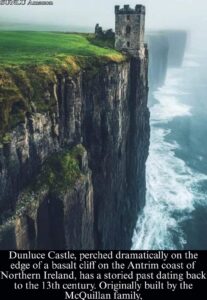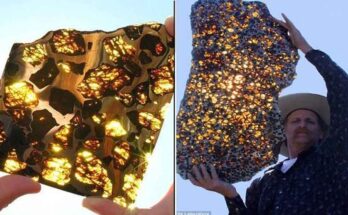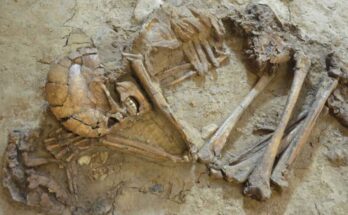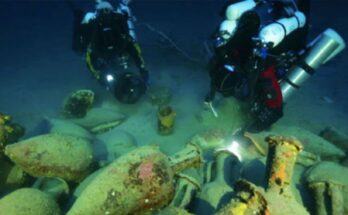**Dunluce Castle** stands as one of the most evocative and historically significant ruins in Northern Ireland, perched on a dramatic basalt cliff along the Antrim coast. This formidable structure, with its rich history and picturesque location, embodies the grandeur and turmoil of medieval Ireland. Here’s a comprehensive description of its history, architecture, and current status:

### **Historical Background**
1. **Origins and Construction**:
– **Date and Builders**: Dunluce Castle’s origins can be traced back to the 13th century. It was originally constructed by the McQuillan family, who were influential landowners in the region. The initial purpose of the castle was to serve as a defensive stronghold to control the surrounding territory and secure the McQuillan clan’s power.
– **Location**: The castle’s strategic location on a basalt outcrop overlooking the North Atlantic Ocean provided a formidable defensive position. The sheer cliffs on three sides of the castle made it an ideal site for fortification, as it was naturally protected from land-based attacks.
2. **MacDonnell Clan Era**:
– **Acquisition**: In the late 16th century, the castle came into the possession of the MacDonnell clan, a powerful family that played a significant role in the politics of the time. The MacDonnells expanded and fortified the castle further, solidifying their control over the area.
– **Significance**: Under the MacDonnells, Dunluce Castle became a prominent seat of power. It was not only a military stronghold but also a symbol of the clan’s status and influence in the region. The castle played a central role in the turbulent politics of the time, including conflicts with rival clans and English forces.
3. **Decline and Abandonment**:
– **Storm Damage**: A major turning point in the castle’s history occurred in 1639, when a severe storm caused a significant portion of the castle’s cliff edge to collapse into the sea. This event led to substantial damage to the structure, including the loss of several buildings and parts of the walls.
– **Abandonment**: Following the storm, the castle’s strategic importance diminished, and the extent of the damage made it increasingly difficult to maintain. By the end of the 17th century, Dunluce Castle was largely abandoned, leaving it in a state of ruin. The castle’s abandonment marked the end of its role as a significant fortification.
### **Architectural Features**
1. **Design and Layout**:
– **Structure**: Dunluce Castle features a mix of medieval and early modern architectural styles. Its layout includes a range of buildings, including residential quarters, defensive walls, and various towers.
– **Defensive Features**: The castle’s design reflects its primary function as a fortification. It includes thick stone walls, battlements, and strategic towers that provided vantage points for defenders. The precarious cliff edge offered a natural defense against attackers from the sea and land.
2. **Notable Buildings**:
– **Main Keep**: The central part of the castle, the main keep, was where the lord and his family resided. This area includes remains of the great hall and living quarters, which would have been lavishly decorated and furnished in their prime.
– **Gatehouse and Walls**: The castle’s gatehouse served as the primary entry point and was heavily fortified. The surrounding walls, though now partly in ruins, once provided a strong defensive barrier against potential invaders.
– **Additional Structures**: Various other buildings and structures were part of the castle complex, including storage rooms, kitchens, and a chapel, reflecting the self-sufficient nature of the medieval castle.
### **Current Status and Preservation**
1. **Tourist Attraction**:
– **Access**: Today, Dunluce Castle is a popular tourist destination, attracting visitors with its dramatic setting and historical significance. The site is managed by the Northern Ireland Environment Agency, which oversees its preservation and public accessibility.
– **Views**: The castle offers breathtaking views of the North Atlantic Ocean and the rugged Antrim coastline. Visitors can explore the ruins and imagine the castle’s former grandeur while enjoying the stunning natural scenery.
2. **Preservation Efforts**:
– **Restoration**: While the castle remains in a state of ruin, ongoing preservation efforts aim to protect the site from further deterioration. These efforts include structural stabilization and conservation work to ensure that the site remains safe for visitors and to preserve its historical integrity.
– **Cultural Significance**: Dunluce Castle is not only a historical monument but also a cultural icon, often featured in literature, folklore, and local traditions. Its dramatic appearance and storied past continue to captivate the imagination of visitors and historians alike.
### **Legacy**
Dunluce Castle remains a powerful symbol of Northern Ireland’s medieval heritage. Its history reflects the turbulent times of clan warfare, political intrigue, and the challenges of maintaining a fortress in a rugged and unpredictable environment. The castle’s enduring beauty and historical significance make it a poignant reminder of the region’s rich and complex past, offering a window into a bygone era and the dramatic landscape that shaped it.
***Do you want to see more posts like this? Well, today we are continuing our fundraising drive to reach our goal. All funds raised, go right back into research. If you are able, please help support our group today. Every little bit helps!



